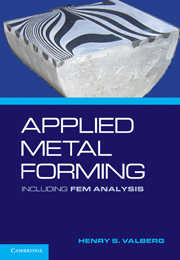Book contents
- Frontmatter
- Contents
- Preface
- APPLIED METAL FORMING
- 1 Characteristics of Metal Forming
- 2 Important Metal Forming Processes
- 3 FEA of Metal Forming
- 4 Theory
- 5 Reduction and Proportions of the Plastic Zone
- 6 Deformations from the Velocity Field
- 7 Technological Tests and Physical Simulation
- 8 Flow Stress Data
- 9 Formability and Workability
- 10 Friction and Friction Models
- 11 Thermal Effects
- 12 Experimental Metal Flow Analysis
- 13 Theoretical Methods of Analysis
- 14 Finite Element Analysis
- 15 FEA of Technological Tests
- 16 Forging
- 17 FEA of Forging
- 18 Extrusion
- 19 FEA of Extrusion
- 20 Rolling
- 21 FEA of Rolling
- 22 Drawing of Wire, Profiles, and Tubes
- 23 FEA of Wiredrawing
- 24 Sheet-Metal Forming
- Index
5 - Reduction and Proportions of the Plastic Zone
Published online by Cambridge University Press: 05 June 2012
- Frontmatter
- Contents
- Preface
- APPLIED METAL FORMING
- 1 Characteristics of Metal Forming
- 2 Important Metal Forming Processes
- 3 FEA of Metal Forming
- 4 Theory
- 5 Reduction and Proportions of the Plastic Zone
- 6 Deformations from the Velocity Field
- 7 Technological Tests and Physical Simulation
- 8 Flow Stress Data
- 9 Formability and Workability
- 10 Friction and Friction Models
- 11 Thermal Effects
- 12 Experimental Metal Flow Analysis
- 13 Theoretical Methods of Analysis
- 14 Finite Element Analysis
- 15 FEA of Technological Tests
- 16 Forging
- 17 FEA of Forging
- 18 Extrusion
- 19 FEA of Extrusion
- 20 Rolling
- 21 FEA of Rolling
- 22 Drawing of Wire, Profiles, and Tubes
- 23 FEA of Wiredrawing
- 24 Sheet-Metal Forming
- Index
Summary
As described in connection with eq. 4-24, the deformations imposed on a material in a general complex deformation condition can be described uniquely by the specification of the numerical values of six different strain components. An alternative simpler approach is to quantify deformations by means of the effective strain value; see eq. 4-38. This strain parameter can be considered the “resultant” strain that takes into account the effect of all different strain components.
In an industrial metal forming process, however, the conditions are complex. It is not straightforward to quantify either the different strain components or the effective strain value. To consider the total deformation imposed on a workpiece in such industrial processes, some simplified, less scientific deformation measures are therefore commonly used. Such common measures, which characterize the size of the deformations imposed on a workpiece in a forming process, are, for instance, the area reduction, or the reduction ratio. By means of the numerical value of these parameters, it is possible to compare the size of the overall deformation in different cases of forming. Some simple deformation measures applied in industry will be defined and discussed in this chapter.
Area Reduction in Stationary Metal Forming Processes
Let us first consider total deformations subjected to the workpiece in some stationary metal forming processes like stretching, drawing, extrusion, and rolling. Sketches of these processes are shown in Fig. 5.1. The workpiece has initial diameter d0 and cross-sectional area A0.
- Type
- Chapter
- Information
- Applied Metal FormingIncluding FEM Analysis, pp. 77 - 83Publisher: Cambridge University PressPrint publication year: 2010



